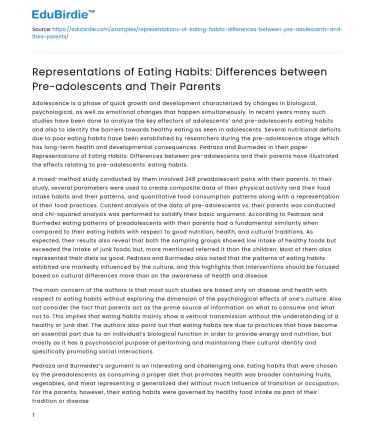Adolescence is a phase of quick growth and development characterized by changes in biological, psychological, as well as emotional changes that happen simultaneously. In recent years many such studies have been done to analyze the key effectors of adolescents’ and pre-adolescents eating habits and also to identify the barriers towards healthy eating as seen in adolescents. Several nutritional deficits due to poor eating habits have been established by researchers during the pre-adolescence stage which has long-term health and developmental consequences. Pedraza and Burmedez in their paper Representations of Eating Habits: Differences between pre-adolescents and their parents have illustrated the effects relating to pre-adolescents' eating habits.
A mixed-method study conducted by them involved 248 preadolescent pairs with their parents. In their study, several parameters were used to create composite data of their physical activity and their food intake habits and their patterns, and quantitative food consumption patterns along with a representation of their food practices. Content analysis of the data of pre-adolescents vs. their parents was conducted and chi-squared analysis was performed to solidify their basic argument. According to Pedraza and Burmedez eating patterns of preadolescents with their parents had a fundamental similarity when compared to their eating habits with respect to good nutrition, health, and cultural traditions. As expected, their results also reveal that both the sampling groups showed low intake of healthy foods but exceeded the intake of junk foods, but, more mentioned referred it than the children. Most of them also represented their diets as good. Pedraza and Burmedez also noted that the patterns of eating habits exhibited are markedly influenced by the culture, and this highlights that interventions should be focused based on cultural differences more than on the awareness of health and disease.
Save your time!
We can take care of your essay
- Proper editing and formatting
- Free revision, title page, and bibliography
- Flexible prices and money-back guarantee
The main concern of the authors is that most such studies are based only on disease and health with respect to eating habits without exploring the dimension of the psychological effects of one’s culture. Also not consider the fact that parents act as the prime source of information on what to consume and what not to. This implies that eating habits mainly show a vertical transmission without the understanding of a healthy or junk diet. The authors also point out that eating habits are due to practices that have become an essential part due to an individual’s biological function in order to provide energy and nutrition, but mostly as it has a psychosocial purpose of performing and maintaining their cultural identity and specifically promoting social interactions.
Pedraza and Burmedez’s argument is an interesting and challenging one, Eating habits that were chosen by the preadolescents as consuming a proper diet that promotes health was broader containing fruits, vegetables, and meat representing a generalized diet without much influence of transition or occupation. For the parents, however, their eating habits were governed by healthy food intake as part of their tradition or disease.
The authors have managed to exemplify numerous real cultural aspects to vividly illustrate their points. There are some problems too. We note however that the discrepancies that have aroused due to cultural and traditional differences among the parents and their preadolescents have no proper means of evaluation. The authors have also chosen a much smaller sampling group that provides less significant statistical analysis. Also, the cultural aspects drawn in this text are mainly based in Mexico and thus in this sense the study tends to take a more biased approach. Also, the authors mention that “these results cannot be generalized to the entire Mexican population…not all participants wanted to share their answers in the interview” (p.18). Connected to this problem of predisposition in their study by the limitations of its scope. Pedraza and Burmedez have not illustrated the influence of medical professionals and the social representation that each holds true to the patterns of eating habits. As with most studies, no further solution or approach to handling the problems related to obesity and diabetes in the Mexican population was illustrated.
In summary, Pedraza and Burmedez have been largely successful in providing the sociocultural aspects that govern the food choice and patterns among preadolescents; however, their lack of social construct and biasness toward one fragmented ethnicity along with the disregard of health professionals and agencies have created an incomplete sense of evaluation.






 Stuck on your essay?
Stuck on your essay?

